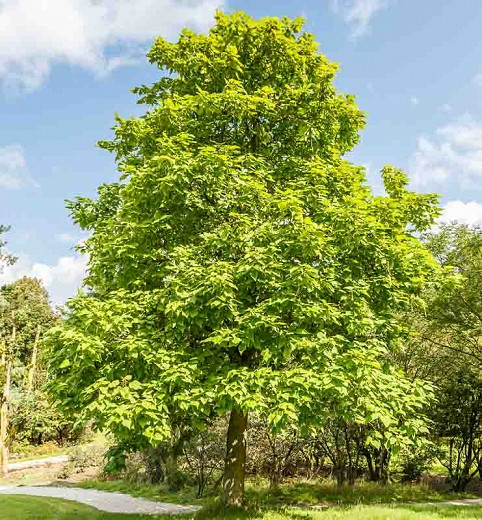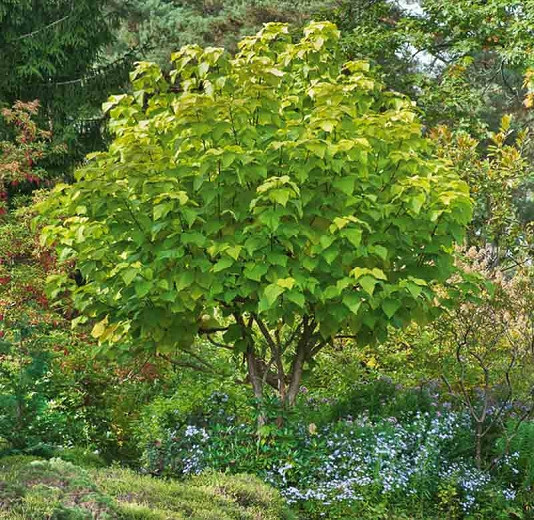Catalpa speciosa (Northern Catalpa)
Award-winning Catalpa speciosa (Northern Catalpa) is a large deciduous tree adorned with a narrow, oval crown and spreading branches clothed with huge, heart-shaped, light green leaves, 12 in. long (30 cm). They are glossy on top and densely hairy on their undersides. In late spring to early summer, ravishing clusters of trumpet-shaped, white flowers, 2 in. across (5 cm), with abundant yellow stripes and purple speckles on their throats, bloom dramatically above the leaves. The flowers give way to long slender green seedpods, 8-20 in. long (20-50 cm), that mature in fall to dark brown and persist through winter. The foliage usually turns yellow in the fall. The pale gray to reddish-brown bark is fissured and prominently ridged on mature trunks. Fast-growing and relatively short-lived, Northern catalpa is very adaptable to adverse conditions.
- Recipient of the prestigious Award of Garden Merit of the Royal Horticultural Society.
- Grows up to 50-70 ft. tall (15-21 m) and 20-50 ft. wide (6-15 m).
- Thrives in average, moist, well-drained soils in full sun or part shade. This tree is not fussy about soil conditions but prefers moist, fertile, loams. Shelter from strong winds as these may damage the large leaves
- Virtually pest free. Keep an eye out for verticillium wilt. Deer resistant.
- No routine pruning necessary. Remove diseased, damaged, congested or crossing shoots.
- Propagate by softwood cuttings or grafting.
- Native to the central United States.
Requirements
| Hardiness | 4 – 8 |
|---|---|
| Heat Zones | 1 – 8 |
| Climate Zones | 2, 2A, 2B, 3, 3A, 3B, 4, 5, 6, 7, 8, 9, 10, 11, 12, 13, 14, 15, 16, 17, 18, 19, 20, 21, 22, 23, 24 |
| Plant Type | Trees |
| Plant Family | Catalpa |
| Exposure | Full Sun, Partial Sun |
| Season of Interest | Spring (Mid,Late)Summer (Early,Mid,Late)Fall |
| Height | 50' – 70' (15m – 21m) |
| Spread | 20' – 50' (6m – 15m) |
| Water Needs | Average |
| Maintenance | Average |
| Soil Type | Chalk, Clay, Loam, Sand |
| Soil pH | Acid, Alkaline, Neutral |
| Soil Drainage | Moist but Well-Drained |
| Characteristics | Plant of Merit, Showy |
| Native Plants | United States, Midwest, Illinois, Indiana, Iowa, Kansas, Michigan, Minnesota, Missouri, Nebraska, North Dakota, Ohio, South Dakota, Wisconsin, Northeast, Connecticut, Maine, Massachusetts, Maryland, New Hampshire, New York, Pennsylvania, Rhode Island, Utah, Southeast, Alabama, Arkansas, Georgia, Kentucky, Louisiana, Mississippi, North Carolina, South Carolina, Tennessee, Virginia, West Virginia, Southwest, Oklahoma, Texas |
| Tolerance | Clay Soil, Deer |
| Attracts | Hummingbirds |
| Garden Styles | Prairie and Meadow |




